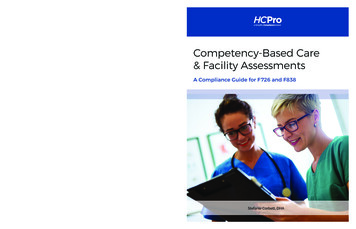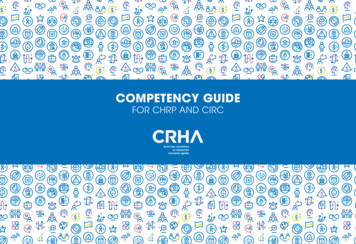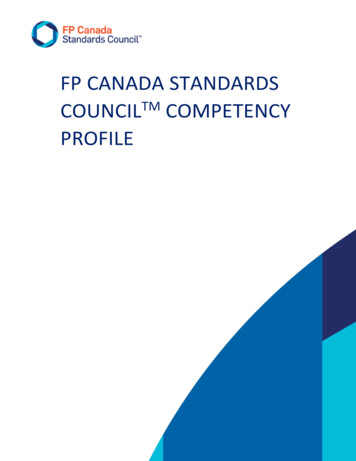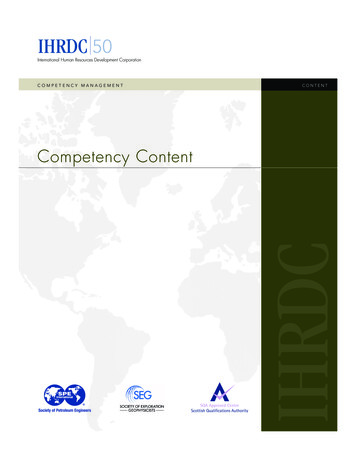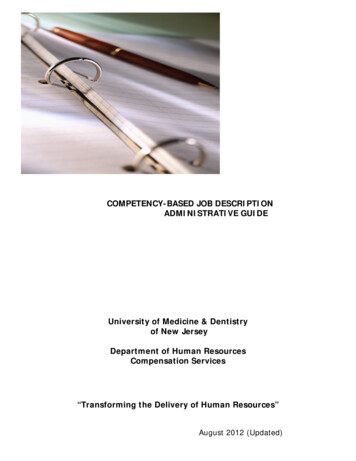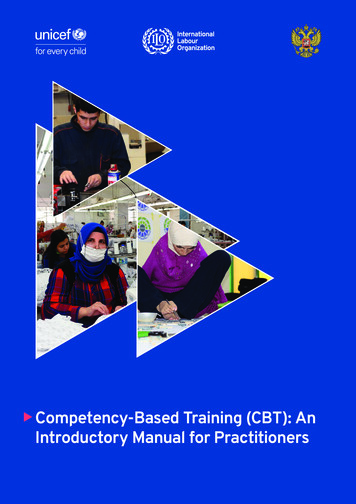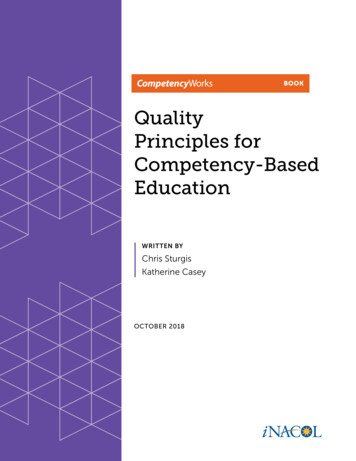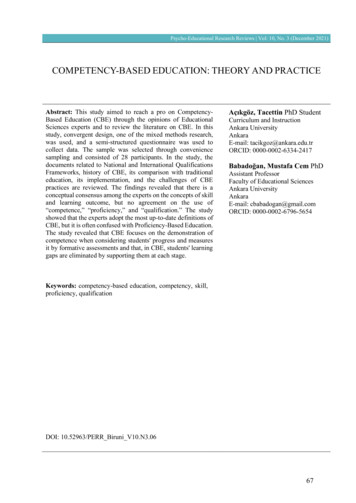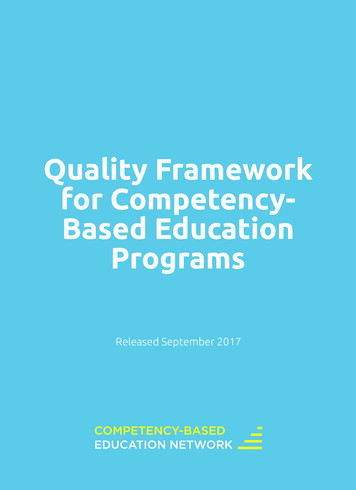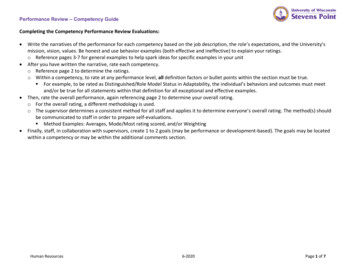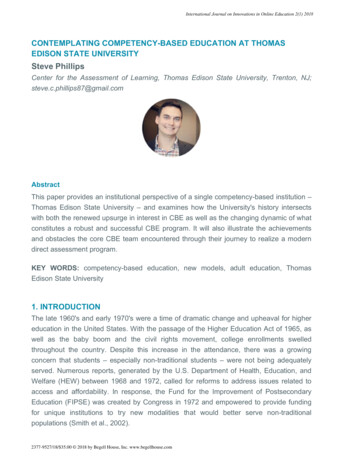
Transcription
International Journal on Innovations in Online Education 2(1) 2018CONTEMPLATING COMPETENCY-BASED EDUCATION AT THOMASEDISON STATE UNIVERSITYSteve PhillipsCenter for the Assessment of Learning, Thomas Edison State University, Trenton, NJ;steve.c.phillips87@gmail.comAbstractThis paper provides an institutional perspective of a single competency-based institution –Thomas Edison State University – and examines how the University's history intersectswith both the renewed upsurge in interest in CBE as well as the changing dynamic of whatconstitutes a robust and successful CBE program. It will also illustrate the achievementsand obstacles the core CBE team encountered through their journey to realize a moderndirect assessment program.KEY WORDS: competency-based education, new models, adult education, ThomasEdison State University1. INTRODUCTIONThe late 1960's and early 1970's were a time of dramatic change and upheaval for highereducation in the United States. With the passage of the Higher Education Act of 1965, aswell as the baby boom and the civil rights movement, college enrollments swelledthroughout the country. Despite this increase in the attendance, there was a growingconcern that students – especially non-traditional students – were not being adequatelyserved. Numerous reports, generated by the U.S. Department of Health, Education, andWelfare (HEW) between 1968 and 1972, called for reforms to address issues related toaccess and affordability. In response, the Fund for the Improvement of PostsecondaryEducation (FIPSE) was created by Congress in 1972 and empowered to provide fundingfor unique institutions to try new modalities that would better serve non-traditionalpopulations (Smith et al., 2002).2377-9527/18/ 35.00 2018 by Begell House, Inc. www.begellhouse.com
PhillipsThomas Edison State College (TESC) was one of a handful of schools founded in theearly 1970's and assisted by FIPSE with the goal of providing access to higher educationfor adult students. SUNY Empire State College, Regents College (now Excelsior), andCharter Oak State College all have similar origins, and emerged from the same collegeaccess and completion agenda. What made these schools unique was their focus onstudent outcomes, rather than seat time, and their willingness to accept authenticdemonstrations of competencies as a proxy for learning.Fast forward 45 years, and higher education in the United States is at a similar point ofuncertainty. While enrollments surged throughout the Great Recession, so did the cost oftuition, causing many to question whether the increasing cost of a college degree reflectedits value. Even the successful completion of a college degree no longer offers the sameopportunities in the workforce. According to a 2016 study done by the Federal ReserveBank of New York, as many as 45% of recent college graduates are employed in a rolethat does not require a college degree (Abel and Deitz, 2016). Once again students,parents, and policymakers wonder if students are being adequately served by the existinginstitutions. And in response to the public's outcry for accountability, educators are onceagain turning towards a model that values outcomes and authentic demonstrations – amodel known as competency-based education (CBE).As Competency-Based Education has come back into style among educators, manyauthors point to the FIPSE-funded college-completion schools from the 1970s as the firstwave of innovators (Thackaberry, 2016). While the methods and tools of measuringcollege-level learning may have grown in sophistication since then, the core principlesremain the same. It does not matter where a student learned something, as long as theycan demonstrate it. Seemingly then, it comes as no surprise that all of these earlyinnovators have been experimenting with the more modern version of CBE. Charter OakState College, Excelsior College, and Thomas Edison State University have all publiclyannounced that they are developing programs, and are all members of the Lumina-fundedCompetency-Based Education Network, aimed at developing common standards anddesign principles for modern CBE.None of these schools, however, have had the same success as new entrants in themarket. Some have released so-called “course-based” competency-based educationprograms which tie assessments within courses to competencies. However, this modeloffers few of the advantages that are common of these more modern CBE programs, suchas allowing students to advance at their own pace or to earn a credential that does nottranslate neatly to traditional credit hours. None of these early innovators have yetlaunched an approved direct assessment program. Meanwhile, schools like Southern NewHampshire University with its College for America (CfA), University of Wisconsin –International Journal on Innovations in Online Education
Contemplating Competency-Based Education at Thomas Edison State UniversityExtension, and Capella University have developed accredited programs that haveattracted thousands of students in a few short years (CFA Staff, 2015; Mason, 2016). Whyis it then that these early innovators, with their distinctive experience in this model ofinstruction and assessment, have failed to keep pace? This article will look at the history ofa single institution – Thomas Edison State University – to provide insight into thechallenges that these legacy institutions face.2. COMPETENCY-BASED EDUCATION AT THOMAS EDISON STATECOLLEGEFounded the same year as the FIPSE, Thomas Edison State College (TESC) was aninstitution borne out of the access agenda in Washington, and Malcolm Knowles' theory ofandragogy. Situated on the Princeton University campus, TESC was originally comprisedof a single pre-war building, and the programs were designed specifically for self-directedadult learners who possessed college-level experience. According to its first coursecatalog, the college was “established in recognition of the fact that there are many ways togain knowledge. As a result, it will carry out evaluations of college-level learning, no matterhow this learning was acquired – through experience, self-study, college courses takenlong ago, educational programs offered by industry, the military or labor unions, and thelike” (Thomas A. Edison College, 1973). In short, students could transfer in credits fromanother institution, participate in the College's credit-by-exam program, or petition theinstitution to perform what they called a “Special Assessment.” Special Assessments aredescribed as “oral, written, and performance examinations or the evaluation of portfolios ofartistic, literary, or musical accomplishments” (Thomas A. Edison College, 1973). Thismethodology was a sharp departure from the traditional ‘sage on the stage’ academicmindset that had characterized higher education up to this point. It also provided newopportunities for students equipped with relevant life experience to secure an affordableand meaningful credential. In subsequent publications, TESC would refer to this method ofevaluation as “competency-based.”Over the next three years, the institution grew to over 3,000 students and began to expandand formalize its offerings. The special assessment was transformed into the portfolioassessment and given more consistent requirements. Students were asked to collectevidence of their mastery, and then to write a short narrative placing that evidence in abiographical and academic context. Meanwhile, the institution added new degreeprograms and encouraged students to attend other colleges to earn credit towards theirdegree requirements. In essence, TESC was more of an education aggregator than aformal institution of learning. Over the next decade, however, the College's identity beganto change with the introduction of telelearning.Volume 2, Issue 1, 2018
PhillipsIn 1982, the College began exploring the potential to use (at the time) state-of-the-arttechnology to provide courses to students. Computer assisted instruction, telecourses,telelearning, teleconferencing, audio courses, satellite delivered instruction, and otherlearning opportunities were becoming broadly available. College staff recognized that itsstudents – adult distance learners – needed access to these learning opportunities, adviceon how to select among them, and support in using them. Significant resources wereallocated to developing an institutional capacity to create and administer courses via VHS,public television, and cable networks. By 1998, TESC prided itself as a leader in the fieldof distance education with over 100 courses available and an inventory of over 9,000tapes (Seaton, 2011).While building out their telecourse capacity, TESC began to innovate with othereducational technologies. In 1984, FIPSE returned to provide the funding to develop thecollege's first online instructional capabilities. Christened “Guided Study,” this programallowed faculty mentors to engage with the students over email to help facilitate theirprogress through the telecourses. With the aid of a 1.8 million Challenge Grant awardedby the N.J. Board of Higher Education in 1986 under the Kean administration, GuidedStudy quickly evolved into the CALL Network's Simulated Classroom, the institution's firsttruly online education experience (Maehl, 1999; N.J. State Dept. of Higher Ed., 1987).Students could register and pay for courses, interact with course materials, and contacttheir faculty mentor, all through an online interface (Seaton, 2011).Online and telecourses proved to be tremendously popular with students, and as such,resources were increasingly devoted to growing the institutional capacity necessary toprovide them. Meanwhile, prior learning assessment changed from the primary offering ofthe institution, to just one of a suite of services provided to enrolled students. In 2010, thedepartment responsible for internal and external academic offerings – Distance andIndependent Adult Learning (DIAL) – was reorganized. The centralized instructional designand learning management system support responsibilities were passed to the newlycreated Center for Learning and Technology. Meanwhile, prior learning assessment(including portfolio, credit-by-exam, and the College's Academic Program Review office)became the charge of the Center for the Assessment of Learning. This division exemplifiedthe growing conflict between the original mission of the institution and the growth of itsmost profitable innovation.Even as TESC was aggressively expanding its course catalog, the nationwide competitionfor students was increasing dramatically. As online learning entered the mainstream,between 2000-2010 the number of US students enrolled in at least one online course hadrisen by an incredible 380%, and the total had reached over 6 million students (Allen andSeaman, 2013). Moreover, TESC's specific subset of the higher education market – adultInternational Journal on Innovations in Online Education
Contemplating Competency-Based Education at Thomas Edison State Universitystudents – was increasingly targeted by other providers. Online for-profit universities sawtheir enrollments swell into the hundreds of thousands through direct marketing campaignsto employers and the armed forces (Davidson, 2015). Despite this, TESC's enrollmentscontinued to rise throughout the 2000's, reaching 20,000 for the first time in 2012 (Pruitt,2012). Much of this rise can be attributed to increasing active duty military and veteranstudents who had access to the Post-9/11 GI Bill educational assistance, as well as themassive number of adults who pursued degrees in the wake of the Great Recession(U.S.C. §§3327, 2016).Despite its success, TESC felt that in such a competitive environment it needed tocontinue to evolve. Further, there was a growing number of issues with the College'scurrent model including: the rising cost of textbooks and other educational resources, thegrowing perception of a student skills gap, and the question of how to credential studentswho had vast knowledge and skills which did not fit squarely into three credit increments(Singer, 2012). As a nexus for assessing and credentialing workplace and non-creditlearning, the Center for the Assessment of Learning was slowly converted into a hub fortesting out new trends in higher education that aimed to solve some of these issues. In late2012, the head of the center successfully lobbied internally for resources to explore theutility of open educational resources (OER), as well as the feasibility of developing acompetency-based education program (Thomas A. Edison State College, 2012). Over thenext 18 months, the CBE team developed a unique model for modern competency-basededucation which leveraged the institution's vast experience in assessment, and built uponthe themes and goals of its founding.3. A NEW MODEL EMERGESThe road to a competency-based education model was not an easy one. Once the Centerfor the Assessment of Learning had been granted funding to explore the possibility ofbuilding a CBE program, they formed an exploratory committee. The committee, whichwas comprised of representatives from all corners of the institution, reviewed emergingCBE models such as those of Northern Arizona University, Southern New HampshireUniversity, Capella University, and Western Governor's University. However, outside ofthese schools, few institutions had successfully launched a CBE program, and many ofthose that had shown signs of early success were heavily subsidized by grants. As aresult, there was a noticeable dearth of efficacy research that could help supportinvestment in such a large undertaking.Technology was another area which presented serious obstacles to progress. As ofJanuary 2013, TESC had transitioned to using Moodle as the learning managementsystem (LMS) for their traditional online courses (Thomas A. Edison State College,Volume 2, Issue 1, 2018
Phillips2013a). Unfortunately, Moodle's functionality did not enable students to enroll inindividualized, self-paced modules, and also lacked means to support the robust coachingthat is at the heart of an effective CBE program (Desrochers and Staislof, 2016; Heles,2014). For TESC, however, replacing Moodle was not an option. Not only did theinstitution lack the resource capacity to design a technology solution in-house, but theyalso did not have the funding to capitalize the creation a third-party design. Additionally,after a recent time-consuming and costly conversion from Blackboard to Moodle, therewas little appetite for conversations around a new LMS.Despite the consensus from the initial exploratory committee that there were numerousadvantages explicit in the design of a CBE program (student-focused program, whichemphasized aggressive faculty coaching, rigorous and transparent outcomes andassessments, and technologically sophisticated design), the committee felt the fieldneeded more time to develop before TESC made any concrete investments in a CBEprogram. The committee did, however, produce a whitepaper which detailed a number ofelements that they felt were critical to the development of a program that leveraged theCollege's history and expertise. Among them were:1. Clearly defined, discrete assessments2. Transparent competency statements that combined workforce application with liberalstudies3. A vigorous diagnostic intake process that leveraged the school's prior learningassessment expertise4. Commitment to OER (Thomas Edison State College, 2013b)The committee submitted its report in December of 2013, recommending closeobservation of the CBE field, but no overt action. However, in an attempt to maintain themomentum and optimism towards this kind of modern CBE, a few committee membersturned their focus towards legitimizing the individual features of the program. The firstchallenge they needed to overcome was to develop a competency framework for a degreeprogram.As mentioned previously, there were few existing CBE models that could be evaluated orleveraged. Further, regulatory guidance was almost non-existent, and where it did exist,was contradictory and confusing. As such, TESC had to rely on its existing curriculum andrequirements to serve as the foundation for its CBE model. The CBE team selected twodegree programs that would serve as the pilot sandboxes for innovation: the Masters ofBusiness Administration (MBA), and the Associates of Arts in Liberal Studies (AALS).These selections would allow the team to experiment with both undergraduate and aInternational Journal on Innovations in Online Education
Contemplating Competency-Based Education at Thomas Edison State Universitygraduate degrees. Further, by building out the AALS, they would have an opportunity totackle the institution's general education requirements. Once competencies were createdthat could satisfy the general education requirements, they could be leveraged to form thebasis for future development of a Bachelor's degree. Based on the recommendations fromthe original exploratory committee's white paper, the CBE team decided to design bothdegrees as direct assessment programs, rather than course-based competency programs.While this choice led to an increase in the complexity of the design process, the team feltthat a direct assessment program provided significantly more value to students in terms oftransparency of the credential, cost effectiveness, and speed to degree.Each degree was tackled independently by a committee of faculty subject matter experts,supported by the CBE team. The AALS committee started by reviewing the institutionaldegree requirements for the established program, as well as two field-facing frameworksdesigned to provide reference points for degree level proficiencies: the AAC&U ValidAssessment of Learning in Undergraduate Education (VALUE) rubrics, and the LuminaFoundation's Degree Qualifications Profile (DQP) (Adelman et al., 2014; Association ofAmerican Colleges & Universities, 2009). This committee quickly realized that thedimensions dictated by the DQP were not quite inclusive enough to be used a guide. Forexample, in the Ethical Reasoning section, the DQP asks students to identify and analyzeethical issues in politics, economics, health care, technology, etc. However, the DQPlacked any discussion of ethical decision making or self-reflective ethics. Meanwhile, thecommittee found the VALUE rubrics to be more aligned with the task of determining thedimensions for degree level assessment. The rubric's core expectations provided thecommittee with a useful mental framework, and ultimately their impact is clearly visible inthe finalized competency map.After months of collaboration, the AALS committee settled on a three-tiered hierarchy ofCompetency Groups, Domains, and Statements. Competency Groups were designed as acollection of domains scaffolded with increasing complexity and rigor. Group 1 focused onthe practical and intellectual skills that a student needs to succeed in a collegeenvironment and included domains such as written and oral communication, informationliteracy, quantitative literacy, etc. Group 2 encourages students to take those skills andapply them in a variety of subject-based contexts. This group featured domains such asIntercultural Knowledge, Ethical Reasoning, and Global Learning. Finally, Group 3 focuseson transferability and metacognition, asking students to reflect on their education and usetheir skill and subject abilities in new ways. Competency Domains embodied theoverarching themes from the degree program. It was here that some of the coreexpectations from the VALUE rubrics were introduced.Volume 2, Issue 1, 2018
PhillipsCompetency Domains framed institutional outcomes in ways that would be recognizable tocurrent and future stakeholders (i.e. graduate school, employers, etc.). Finally,Competency Statements detailed discrete skills and abilities in which students woulddemonstrate their mastery. To develop these statements, the committee reviewed all ofthe courses that satisfied the various degree requirements in the AALS, and selectedcommon themes (i.e. in all courses that speak to the institution's information literacyrequirement, which skills and activities are repeated.) The number of competencystatements per domain varied based on the complexity of the domain content. Thissmallest tier would be the level at which students in the direct assessment program wouldbe credentialed.Meanwhile the MBA committee took a slightly different approach. While they wereconsistent with the design of a three-tiered framework, rather than constructing the groupsbased upon complexity, they divided the competency domains between required andelective. Simply, the competency domains in the required group reflected the coreexpectations of the degree program, and served to provide students with a foundation ingraduate work. Through the competency domains in the elective group, students couldselect their unique specialization within the MBA program †. The committees differed withhow they developed competency statements as well. Whereas the AALS committeecreated new statements based on repeating themes, the MBA committee used the MBAcourse objectives as their underpinning. Much of their work entailed modifying the existingobjectives with an eye towards assessment and workforce application.These competency frameworks were well received by both the School of Business andManagement and the School of Arts and Sciences leadership. This work, and the lengthyapproval process that each framework went through with their respective curriculumcommittee, kept competency-based education in the front of mind for many at TESC.However, even after the framework's approval, there was no signal that there would be afirm commitment from institutional leadership for the development of a fully-fledged directassessment program. In the background of the CBE experimentation, TESC enrollmenthad declined for the first time since the 1990s, and the number of students registering forportfolio assessments was close to an all-time low (Thomas Edison State College, 2014).The College began considering a variety of cost-cutting measures, and as such,investments in new methods were not a popular topic. However, having confidence in theintrinsic value of CBE, and in an effort to revitalize the sagging portfolio numbers, the CBEteam pressed forward and continued their experimentation with another key element of theproposed program – the diagnostic intake interview. They believed that by combiningelements of our existing portfolio assessment processes with a more robust facultyInternational Journal on Innovations in Online Education
Contemplating Competency-Based Education at Thomas Edison State Universitycoaching model, they could produce an effective diagnostic that would set students up forsuccess.Over the past four decades, TESC model for portfolio assessment has gone throughseveral alterations. However, the foundational aspects of the process remain unchanged.Traditionally, if a student is interested in earning credit through a portfolio assessment,they start out by searching through the TESC portfolio database for the course or coursesthat best reflects their experience. Once the selection had been approved by a TESCassessment expert, the student begins compiling evidence that their experience hadimbued them with college-level credentials that satisfy the relevant learning outcomes.Evidence can take the form of work products, essays, letters of recommendation,certifications, etc. Along with evidence, the student writes a narrative essay that reflects ontheir experience and connected it to the course outcomes. Upon completion, the portfoliois evaluated by a faculty mentor (Hoffmann, 2014).Meanwhile, the advising services provided to TESC students principally included helpingselect which courses would satisfy specific degree requirements, confirming withdrawaldeadlines, and other specific college guidelines. Psychologist Dr. B. B. Crookstondescribed this type of authority-based question and answer advising as prescriptiveadvising. He stated, “Advisors who use a prescriptive advising approach do not take totalindividual development into consideration. Instead they focus on expressing institutionalauthority” (Crookston, 1972). This method is contrasted against developmental advising,which takes into account human growth, cognitive, affective, career, physical, and moralpersonal goals and objectives (Jordan, 2000). While prescriptive advising is much morecost effective and scalable, the CBE team believed that it was insufficient to supportstudents moving through an already isolating and self-driven competency-based directassessment experience. Given the fact that few TESC students utilize the existing advisingservices, they believed that a different approach was required for this subset of students.The CBE diagnostic intake process would begin after the student had applied, but beforethey had enrolled in a degree program. If they chose to take the CBE route, they would bedirected to the competency degree map, which would list all of the competencies,associated assessments, and rubrics for a specific degree. Next, much like traditionalportfolio students, they would collect evidence and construct a narrative for the evidence.In this model however, they complete this process with competencies in mind, rather thancourse objectives, and in the context of an entire degree program, rather than individualcourses. Once the student submits a diagnostic portfolio, it would be reviewed by a teamconsisting of an assessment specialist and one to three subject matter experts (dependingon the scope of the student's experience). During this preliminary evaluation, theVolume 2, Issue 1, 2018
Phillipscommittee would evaluate students in each competency they chose to challenge, on afour-level rubric (Thomas Edison State College, 2013).The next step in this process would be to engage in an interview with the student,conducted over the phone, through video conferencing software, or in-person, dependingon the preference of the student. During these interviews, the committee would probefurther into the student's experience in order to make concrete determinations regardingtheir level of mastery. Also participating in the interview would be the student's TESCassigned coaching mentor. This subject matter generalist would be paired with a studentduring this initial interaction, and would become the main point of contact for the student'sentire academic career. Through this role, the CBE team hoped to add an element ofdevelopmental advising to this program. Once the diagnostic intake interview wascompleted, the coaching mentor would schedule their first of many regular check in callswith the student and discuss the results. Together, the student and the coaching mentorwould create a plan of action, and discuss the next steps for enrolling in a degree programand registering for competency modules.Working together with the School of Business and Management, the CBE team tested thisprocess with a number of pilot MBA students in the late spring of 2014. They focused on aset of competency statements within the MBA degree program that could be traced backto a traditional three credit course. This way, students who volunteered to participate in thepilot would be able to receive credit. The student response was overwhelmingly positive,but the pilot did reveal some potential issues. The first obstacle was related todocumentation. All of the students who participated had rich conversations with theevaluation team that uncovered experience and competency far beyond the initial portfoliosubmission. Unfortunately, aside from the team's notes and the information which wasdetailed in the rubrics, there was no way to capture this richness. Further, all grading andrecord keeping was manual. This was not an issue for the purposes of the pilot; however,the team agreed that, where possible, the introduction of technology and automation wasnecessary for effective scalability.On the back of these initial efforts, TESC's leadership approved additional exploration.They commissioned a detailed project plan, cost and enrollment projections, and begandiscussions with Middle State Commission on Higher Education (MSCHE). The CBE teamestimated that the overall costs for developing a direct assessment program would cost inthe low seven figures spread across three years. By the fourth year, the program wouldbecome cash positive, and it would break even by year six. However, given the budgetaryconstraints of the institution, the CBE team was granted a budget in the low six figures tocontinue to pursue their experimentation, and was encouraged to seek additional fundingfrom the College's independent, charitable fundraising foundation and alumni association.International Journal on Innovations in Online Education
Contemplating Competency-Based Education at Thomas Edison State University4. IMPLEMENTATION CHALLENGESWith the budget in hand, the CBE team began to move forward on several fronts. Themain priorities were to develop a curriculum and to select a technology solution that couldbe used to both deliver the curriculum as well as support the robust coaching model theyenvisioned. Without the capacity to recruit an internal instructional design team, theyneeded to look elsewhere for curricular support. Further complicating matters was the CBEteam's steadfast commitment to using open education resources (OER) throughout thecurriculum. They felt that there was a natural synergy between the modularity of a CBEprogram and flexibility provided by OER. By using OER, students would not be required topurchase an entire textbook to use the relevant chapter(s) for a given module. Moreover,the CBE team at Thomas Edison State University (TESU) † was keen to start a largerconversation within the CBE community around questions of standardization. By pr
2. COMPETENCY-BASED EDUCATION AT THOMAS EDISON STATE COLLEGE Founded the same year as the FIPSE, Thomas Edison State College (TESC) was an institution borne out of the access agenda in Washington, and Malcolm Knowles' theory of andragogy. Situated on the Princeton University campus, TESC was originally comprised
